 W
WAn alpenstock is a long wooden pole with an iron spike tip, used by shepherds for travel on snowfields and glaciers in the Alps since the Middle Ages. It is the antecedent of the modern ice axe.
 W
WAn ascender is a device used for directly ascending a rope, or for facilitating protection with a fixed rope when climbing on very steep mountain terrain.
 W
WAn avalanche transceiver or avalanche beacon is a type of emergency locator beacon, a radio transceiver operating at 457 kHz for the purpose of finding people buried under snow. They are widely carried by skiers, particularly back country skiers for use in case a skier is buried by an avalanche. Before setting out on an expedition, all the members of a group will activate their transceivers in the transmit mode, causing the device to emit low-power pulsed radio signals during the trip. Following an avalanche, if some members of the ski party are buried, the others may switch their transceivers from transmit into receive mode, allowing use as a radio direction finding device to search for signals coming from the lost skiers. The avalanche beacon is an active device powered by batteries; a ski suit may also contain a passive RECCO transponder sewn into the clothing.
 W
WA belay device is a mechanical piece of climbing equipment used to control a rope during belaying. It is designed to improve belay safety for the climber by allowing the belayer to manage their duties with minimal physical effort. With the right belay device, a small, weak climber can easily arrest the fall of a much heavier partner. Belay devices act as a friction brake, so that when a climber falls with any slack in the rope, the fall is brought to a stop.
 W
WBottled oxygen is oxygen in small, portable, high pressure storage cylinders, as used for high-altitude climbing. Bottled oxygen may also be for a breathing gas, especially for scuba diving or during surgery.
 W
WCamalot is a brand of spring-loaded camming devices manufactured by Black Diamond Equipment used to secure ropes while rock climbing.
 W
WA carabiner or karabiner is a specialized type of shackle, a metal loop with a spring-loaded gate used to quickly and reversibly connect components, most notably in safety-critical systems. The word is a shortened form of Karabinerhaken, a German phrase for a "spring hook" used by a carbine rifleman, or carabinier, to attach his carabin to a belt or bandolier.
 W
WA climbing harness is an item of climbing equipment for rock-climbing, abseiling, or other activities requiring the use of ropes to provide access or safety such as industrial rope access, working at heights, etc. A harness secures a person to a rope or an anchor point.
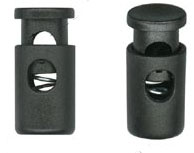 W
WA plastic cord lock attaches to drawstrings and tightens without the use of knots. Cord locks allow mountaineers to fasten clothing and camping equipment quickly in cold conditions when the fingers are encased in heavy gloves. They consist generally of three parts: a barrel, a toggle (plunger), and a spring. Squeezed together, tension is released and the cord lock can move freely up and down the cords. Released, the tension is engaged and the cord lock stays in place. They come in many sizes and shapes to suit to any purpose, including plastic cord lock, mini size cord lock, no spring cord lock, with spring cord lock, with rim cord lock.
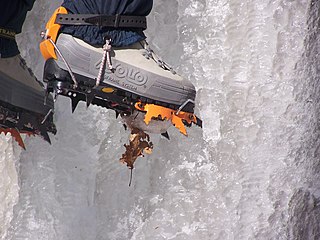 W
WA crampon is a traction device that is attached to footwear to improve mobility on snow and ice during ice climbing. Besides ice climbing, crampons are also used for secure travel on snow and ice, such as crossing glaciers, snowfields and icefields, ascending snow slopes, and scaling ice-covered rock. There are three main attachment systems for footwear: step-in, hybrid, and strap bindings. The first two require boots with welts, as a tension lever attaches the crampon to the heel. The last type are more versatile and can adapt to virtually any boot or shoe, but often do not fit as precisely as the other two types.
 W
WA dynamic rope is a specially constructed, somewhat elastic rope used primarily in rock climbing, ice climbing, and mountaineering. This 'stretch' is what makes it 'dynamic', in contrast to a static rope that has very low elongation under load. Greater stretch allows a dynamic rope to absorb the energy of a sudden load such as from a fall more slowly, reducing the peak force and therefore the chance of catastrophic failure. Kernmantle ropes are the most common type of dynamic rope, and nylon has replaced all natural materials such as hemp since 1945 for durability and strength.
 W
WA grappling hook or grapnel is a device invented by the Romans in approximately 260 BC. The grappling hook was originally used in naval warfare to catch ship rigging so that it could be boarded. They typically have multiple hooks, attached to a rope; it is thrown, dropped, sunk, projected, or fastened directly by hand to where at least one hook may catch and hold. Generally, grappling hooks are used to temporarily secure one end of a rope. They may also be used to dredge for submerged objects.
 W
WA GRIGRI is an assisted braking belay device manufactured by Petzl designed to help secure rock-climbing, rappelling, and rope-acrobatic activities. Its main characteristic is a clutch that assists in braking under a shock load. The success of this device has led to grigri becoming a common name for devices of this type. In 2011 a new version, the GRIGRI 2, was released to replace the original 1991 model. Petzl released the GRIGRI + in 2017, adding safety features to the original design, and 2019 saw the release of an updated version of the device, simply called the GRIGRI.
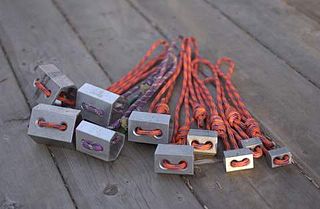 W
WA hex is an item of rock-climbing equipment used to protect climbers from falls. They are intended to be wedged into a crack or other opening in the rock, and do not require a hammer to place. They were developed as an alternative to pitons, which are hammered into cracks, damaging the rock. Most commonly, a carabiner will be used to join the hex to the climbing rope by means of a loop of webbing, cord or a cable which is part of the hex.
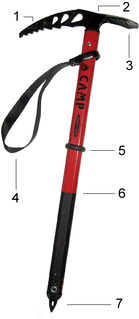 W
WAn ice axe is a multi-purpose hiking and climbing tool used by mountaineers in both the ascent and descent of routes that involve frozen conditions with snow or ice. An ice axe can be held and employed in a number of different ways, depending on the terrain encountered. In its simplest role, the ice axe is used like a walking stick in the uphill hand, the mountaineer holding the head in the center. It can also be buried pick down, the rope tied around the shaft to form a secure anchor on which to bring up a second climber, or buried vertically to form a stomp belay. The adze is used to cut footsteps, as well as scoop/bucket seats in the hillside and trenches to bury an ice axe belay. The long-handled alpenstock was a predecessor to the modern ice axe.
 W
WIce cleats are a contraption, affixed to a shoe or boot, with small spikes underneath. They are used to avoid sliding on slippery surfaces like ice or snow. Ice cleats are attached to footwear with either straps over the heel and toe or a single strip over the foot. Not to be mistaken for crampons used for ice climbing, ice cleats are much smaller and are commonly used in arctic areas.
 W
WAn ice screw is a threaded tubular screw used as a running belay or anchor by climbers on steep ice surface such as steep waterfall ice or alpine ice during ice climbing or crevasse rescue, to hold the climber in the event of a fall, and at belays as anchor points.
 W
WAn ice tool is a specialized elaboration of the modern ice axe, used in ice climbing, mostly for the more difficult configurations. Ice tools are used two to a person for the duration of a pitch, and thus in some circumstances such as top-rope-anchored climbs, a pair may be shared among two or more people, where only one of them at a time is climbing. In contrast a classical "ice axe" is used one to a person for the hours or days a party is traveling across snow or glacier. In communities where it is common to refer to an "ice tool" simply as an "ice axe", classic "ice axes" are often referred to as "traveling axes", "walking axes", or "general mountaineering axes" to distinguish them from "tools".
 W
WIn rock climbing, a nut is a metal wedge threaded on a wire and is used for protection by wedging it into a crack in the rock. Quickdraws are clipped to the nut wire by the ascending climber and the rope threads through the quickdraw. Nuts come in a variety of sizes and styles, and several different brands are made by competing manufacturers. Most nuts are made of aluminum. Larger nuts may be threaded on Dyneema cord instead of wire, but this has become unusual.
 W
WIn climbing, a piton is a metal spike that is driven into a crack or seam in the climbing surface with a climbing hammer, and which acts as an anchor to either protect the climber against the consequences of a fall or to assist progress in aid climbing. Pitons are equipped with an eye hole or a ring to which a carabiner is attached; the carabiner can then be directly or indirectly attached to a climbing rope.
 W
WThe RECCO rescue technology is an electronic method that facilitates organized rescue teams locating people buried by an avalanche or lost in the outdoors.
 W
WA wide range of equipment is used during rock or any other type of climbing that includes equipment commonly used to protect a climber against the consequences of a fall.
 W
WA rope is a group of yarns, plies, fibers or strands that are twisted or braided together into a larger and stronger form. Ropes have tensile strength and so can be used for dragging and lifting. Rope is thicker and stronger than similarly constructed cord, string, and twine.
 W
WA sleeping bag is an insulated covering for a person, essentially a lightweight quilt that can be closed with a zipper or similar means to form a tube, which functions as lightweight, portable bedding in situations where a person is sleeping outdoors. Its primary purpose is to provide warmth and thermal insulation through its synthetic or down insulation. It also typically has a water-resistant or water-repellent cover that protects, to some extent, against wind chill and light precipitation, but a tent is usually used in addition to a sleeping bag, as it performs those functions better. The bottom surface also provides some cushioning, but a sleeping pad or camp cot is usually used in addition for that purpose. The bottom surface of a sleeping bag may be moderately water repellent, but a plastic tarp or groundsheet is often used to protect against moist ground.
 W
WA sling or runner is an item of climbing equipment consisting of a tied or sewn loop of webbing. These can be wrapped around sections of rock, hitched to other pieces of equipment, or tied directly to a tensioned line using a Prusik style knot. They may be used as anchors, to extend an anchor to reduce rope drag, in anchor equalization, or to climb a rope.
 W
WSnow protection is a type of natural or artificial protection used in mountaineering as an anchor. Two common artificial devices are the snow fluke and snow picket. It is used both for climbing and for securing tents and other camping gear, designed for use in sand and snow.
 W
WA spring-loaded camming device is a piece of rock climbing or mountaineering protection equipment. It consists of two, three, or four cams mounted on a common axle or two adjacent axles, so that pulling on the axle forces the cams to spread farther apart. This is then attached to a sling and carabiner at the end of the stem. The SLCD is used by pulling on the "trigger" so the cams retract together, then inserting it into a crack or pocket in the rock and releasing the trigger to allow the cams to expand. A pull on the rope, such as that generated by a climber falling, will cause a properly placed SLCD to convert the pulling force along the stem of the unit into outwards pressure on the rock, generating massive amounts of friction and preventing the removal of the unit from the rock. Because of the large forces which are exerted on the rock when an SLCD is fallen on, it is very important that SLCDs are only placed in solid, strong rock.
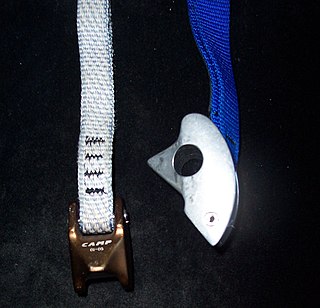 W
WA Tricam is a type of climbing protection equipment. A versatile nut/cam hybrid, the Tricam was invented by Greg Lowe in 1973, and came to market in 1981. They are currently manufactured by C.A.M.P. of Premana Italy.
 W
WA Tricouni is the brand name of a metal nail used on mountain climbing shoes. Widely used in the past by mountain climbers and soldiers, it offers improved gripping on various surfaces. The Tricouni nail was invented in 1912 by a jeweler from Geneva, Félix-Valentin Genecand, alias "Tricouni" (1878-1957). Genecand was also a well known alpinist. Tricouni nails are also referred to as hobnails, boot nails, cleats and shoe studs.
 W
WWebbing is a strong fabric woven as a flat strip or tube of varying width and fibres, often used in place of rope. It is a versatile component used in climbing, slacklining, furniture manufacturing, automobile safety, auto racing, towing, parachuting, military apparel, load securing, and many other fields.